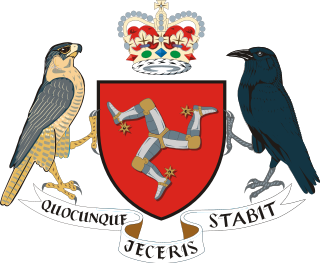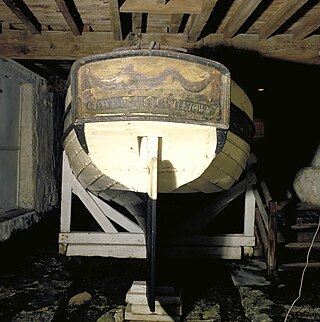
Castletown is a town in the Isle of Man, geographically within the historical parish of Malew but administered separately. Lying at the south of the island, it was the Manx capital until 1869. The centre of town is dominated by Castle Rushen, a well-preserved medieval castle, originally built for a Viking king.
Quayle is a surname of Anglo-Celtic origin, specifically English, Irish, Manx and Scottish.

The Manx are a minority ethnic group originating on the Isle of Man, in the Irish Sea in Northern Europe. They belong to the diaspora of the Gaelic ethnolinguistic group, which now populate the parts of the British Isles and Ireland which once were the Kingdom of the Isles and Dál Riata. The native culture of the Isle of Man is described as Celtic with significant Gaelic, Norse, Norse-Gaelic, and minor northern English influences. The Manx are governed by themselves through Tynwald, the legislature of the island, which was introduced by Viking settlers over a thousand years ago. The native mythology and folklores of the Manx belong to the overall Celtic Mythology group, with Manannán mac Lir, the Mooinjer veggey, Buggane, Lhiannan-Shee, Ben-Varrey and the Moddey Dhoo being prominent mythological figures on the island. Their language, Manx Gaelic is derived from Middle Irish, which was introduced by settlers that colonised the island from Gaelic Ireland. However, Manx gaelic later developed in isolation and belongs as a separate Goidelic language of the Insular Celtic languages.

A Deemster is a judge in the Isle of Man. The High Court of Justice of the Isle of Man is presided over by a deemster or, in the case of the appeal division of that court, a deemster and the Judge of Appeal. The deemsters also promulgate the Laws on Tynwald Day by reading out brief summaries of them in English and Manx.
William Edward "Eddie" Teare, is a Manx politician, who was the Minister of the Treasury from 2011 to 2016 after holding other ministerial positions. He was MHK for Ayre from 2004 to 2016, having first been elected to the House in a 2004 by-election. He was educated at Ramsey Grammar School.

SS (RMS) Ellan Vannin was built as an iron paddle steamer in 1860 at Meadowside, Glasgow for the Isle of Man Steam Packet Company. She was originally named Mona's Isle - the second ship in the company's history to be so named. She served for 23 years under that name before being rebuilt, re-engined and renamed in 1883. As Ellan Vannin she served for a further 26 years before being lost in a storm on 3 December 1909 in Liverpool Bay.
Quine is a Manx surname. Notable people with the surname include:
There is a long history of capital punishment in the Isle of Man. Until the 17th century, many convicted prisoners were executed at Hango Hill.
Corrin is a surname of Norse–Gaelic origin. It is a contraction of MacCorran or McCorryn, an anglicised form of the Gaelic MacTorin, meaning "son of Thórfinnr".

Archibald Knox, was a Manx designer of Scottish descent. He is best known as being Liberty's primary designer at the height of their success and influence upon British and International design. Knox's work bridged the Arts and Crafts Movement, Celtic Revival, Art Nouveau, and Modernism. He is seen as a leading figure of the Modern Style movement.
Corlett is a surname of Manx origin. The name is an Anglicisation of the Gaelic Mac Thorliot, derived from an Old Norse personal name composed of two elements: the name Þórr and ljótr meaning "bright". Another opinion is that the Old Norse Þorliótr may mean "Thor-people". The name appears earliest in records as Corlett in 1504 and MacCorleot in 1511.

Peggy is an armed yacht built in June, 1789 for George Quayle (1751–1835), MHK, a prominent politician and banker on the Isle of Man. She is the oldest surviving Manx craft and is one of only a very few surviving vessels built in the 18th century.

The Church of Jesus Christ of Latter-day Saints in the Isle of Man refers to the Church of Jesus Christ of Latter-day Saints and its members in the Isle of Man. As of 31 December 2022, The Church of Jesus Christ of Latter-day Saints reported 281 members in one congregation, the Douglas Ward, in the Isle of Man. In 2019, the Isle of Man had the 2nd most LDS Church members per capita in Europe, behind Portugal. Despite their small numbers, Manx Mormons have a heritage going back over a hundred and fifty years, which is obscured by their tendency to emigrate to the US and by the LDS Church administering the Isle of Man as part of England, when it is not actually part of the United Kingdom.

John Quine was a Manx clergyman, scholar, novelist, and playwright. He is perhaps best remembered for his 1897 novel, The Captain of the Parish.
John Quayle is the name of the following people:

Stephen Paul Quine, is a Manx-born commercial pilot and former politician who, on August 31, 2002, was pilot in command of the final Manx Airlines flight. On 27 August 2020 he was elected as a Member of the House of Keys for the constituency of Douglas South in a by-election, before narrowly losing his seat at the subsequent General Election.
Silverdale Glen is a National Glen and recreational area near the village of Ballasalla in the parish of Malew on the Isle of Man. The recreation site consists of a small boating lake, café, playing fields, and a playground with a Victorian water-powered carousel.








